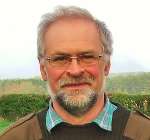In their red Santa costumes brightening a cold grey December cityscape, the Perth streets had been full of hundreds of eager festive runners earlier in the day, signalling that the great Christmas celebration will be here before we know it. Christian values aside, the day throws down a universal marker for us all: joyous for many, but tinged with a wistfulness as thinning Christmas card lists prompt memories of those no longer with us. With the days still shortening, it is a reflective time of year when many seek solace in a deeper spiritual experience, perhaps explaining the popularity of the Scottish Ensemble’s candlelit concerts, moved out of concert halls into lovely historic buildings and timed perfectly to match the thoughtful mood of Advent: St John’s Kirk, where once John Knox thundered from the pulpit, was packed.
Matthew Truscott from the Orchestra of the Age of Enlightenment and the Mahler Chamber Orchestra, paying a rare and welcome visit to Scotland, was guest director or ‘interloper’ as he more playfully put it. We are very used to the crystal clear bright sound from the Scottish Ensemble players under their usual director Jonathan Morton yet Truscott’s approach produced a completely different palette of mellow playing oozing with golden warmth from the same musicians.
Pairing up J.S. Bach with Arvo Pärt was an intriguing choice of programming, yet there was much more to this than was first apparent. Pärt’s atmospheric Fratres was a primer to J.S. Bach’s Violin Concerto in A minor, starting quietly out of nothing as the violins played simple sequences of notes against a drone from the lower strings, patterns of increasing density unfolding in slow crescendo set against the occasional startle of bass drum and wood block. Fading out to the limit of audibility, the players used the furthest tips of their bows as the drone drifted into silence, and deepest darkness. Billed as candlelit, this concert was performed under a huge white helium balloon five feet across from Do Architecture which pulsed with white light according to mood: harsh and bright in harmony with the percussion and warmer otherwise. Although it added some atmosphere to this piece, it contributed little to anything else, and became an increasing distraction as the evening wore on. Continuing with no break, Truscott headed up a lively Concerto in A minor, the Ensemble feeding on the brisk counterpoint, Truscott sounding particularly beautiful in the slower tread of the Andante before showing off some lightning fast decoration in the wilder final movement, making it all appear effortless.
Bach was said to have written his Chorale Prelude Vor deinen Thron Tret ich hiermit on his deathbed, and the Ensemble played a string quartet version with overlapping harmonies and tune. The circumstances inspired Russian composer Sofia Gubaidulina to write her own Meditiation über der Bach Choral: “Vor deinen Thron Tret ich hiermit” scored for five strings and amplified harpsichord. Using unusual methods like the back of the bow col legno in the bass, and bouncing bows off strings in a stuttering unison from the top strings, it was a rather dark disruptive piece, scraping tremulos underpinned with thick dissonant bass chords from the harpsichord, eventually resolving into a B-A-C-H sequence.
Lightening the mood after the break, Truscott was joined by Borders-born Colin Scobie, a rising star and fresh recruit to the Orchestra of the Age of the Enlightenment, in a brilliant warm interpretation of Bach’s Concerto for Two Violins in D minor, the two soloists blending well, especially in the slow movement, taken at a good steady pace. It was fun to watch phrases being passed between the soloists and the ensemble.
Two Arvo Pärt works, Toccata from Collage über B-A-C-H and Summa sandwiched Bach’s Contrapunctus XIX from The Art of Fugue. Pärt’s Toccata played on the B-A-C-H theme was a lively and urgent piece with repeated notes and short stabbing upbows. Bach’s Contrapunctus XIX, a devilish triple fugue was a fine performance of a complicated study in counterpoint, finishing abruptly as the composed died. Pärt’s Summa, a setting of the Credo explored tintinnabulation beguinning with thin expressions developing to a richer multi-layered sound before tailing off.
Finally, the well-known Bach’s Brandenberg Concerto no. 3 in G major was given a twist in the central two chord movement: Stravinsky, in his final days had found solace in arranging Bach’s music for strings, so his version of the B minor Prelude from the Well-Tempered Clavier preceded the final movement, taken at a breath-taking whirl. An encore from the symphonic cantata from the Christmas Oratorio, two violins and a viola taking the shepherds oboe part, sent us out with a seasonal cheer after a thoughtful spiritual journey.


